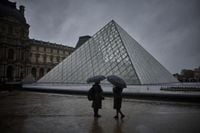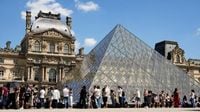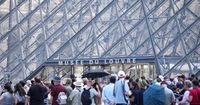On Monday, June 16, 2025, the Louvre Museum in Paris, the world’s most-visited cultural institution, was unexpectedly closed for several hours due to a spontaneous strike by its staff. Thousands of visitors, many clutching their tickets and eager to glimpse masterpieces like Leonardo da Vinci’s Mona Lisa and the Venus de Milo, found themselves stranded outside the iconic glass pyramid designed by I.M. Pei, left confused and frustrated with no clear explanation.
The strike erupted during a routine internal meeting, when gallery attendants, ticket agents, and security personnel collectively refused to take up their posts. Their protest centered on what they described as unmanageable crowds, chronic understaffing, and “untenable” working conditions that have pushed the museum’s employees to their limits. Christian Galani, spokesperson for the C.G.T.-Culture labor union representing Louvre workers, explained that the strike was a wildcat action—an unauthorized work stoppage without a formal union vote. “We didn’t plan to go on strike, but the people are so exhausted, they can’t support the conditions getting worse and worse,” he said.
While the museum spokeswoman characterized the event as a “social movement” rather than a formal strike, the closure lasted about four hours before the Louvre reopened at approximately 2:30 p.m. local time. Talks between workers and management began at 10:30 a.m. and stretched into the afternoon, reflecting the urgent need to address the crisis. The museum is normally closed on Tuesdays, so staff indicated that a full reopening might resume on Wednesday, June 18.
The Louvre’s sudden shutdown is not unprecedented but remains rare. The institution has closed during wartime, the COVID-19 pandemic, and on a handful of occasions due to strikes—most notably in 2013 over safety concerns and in 2019 when overcrowding sparked spontaneous walkouts. Yet this latest disruption feels particularly emblematic of a broader reckoning with overtourism, a challenge faced by cultural landmarks worldwide.
Kevin Ward, a 62-year-old visitor from Milwaukee, Wisconsin, captured the mood outside the museum: “It’s the Mona Lisa moan out here. Thousands of people waiting, no communication, no explanation. I guess even she needs a day off.” His words highlight the strain on both the museum and its guests, as the famed portrait draws crowds more akin to a celebrity meet-and-greet than a contemplative art experience.
Indeed, approximately 20,000 visitors cram daily into the Salle des États, the Louvre’s largest room, just to catch a glimpse of the Mona Lisa behind protective glass. Ji-Hyun Park, a 28-year-old visitor from Seoul, described the scene vividly: “You don’t see a painting. You see phones. You see elbows. You feel heat. And then, you’re pushed out.” Such overcrowding detracts from the appreciation of other masterpieces nearby, like works by Titian and Veronese, which often go unnoticed amid the throng.
The museum’s infrastructure, designed for far fewer visitors, is buckling under the pressure. Last year, the Louvre welcomed 8.7 million visitors—more than double the 4 million it was built to accommodate. Despite attempts to cap daily attendance at 30,000, staff report that the experience remains a “daily test of endurance,” exacerbated by too few rest areas, limited bathroom facilities, and summer heat intensified by the pyramid’s greenhouse effect.
Laurence des Cars, the Louvre’s president, sounded alarm bells months ago in a leaked memo, warning that parts of the building were “no longer watertight,” that temperature fluctuations endangered priceless artworks, and that basic visitor needs—food, restrooms, signage—fell “far below international standards.” She described the visitor experience as “a physical ordeal.”
In response, President Emmanuel Macron unveiled an ambitious decade-long renovation plan dubbed the “Louvre New Renaissance” in January. This €700–800 million ($730–834 million) project aims to modernize the museum’s infrastructure and visitor experience. Key elements include relocating the Mona Lisa to a dedicated room accessible via timed-entry tickets, and constructing a new entrance near the Seine River to alleviate congestion at the pyramid entrance by 2031.
Macron emphasized that “conditions of display, explanation and presentation will be up to what the Mona Lisa deserves,” signaling a commitment to preserving the painting’s dignity and the visitor experience. The renovation is set to be financed through a combination of ticket revenues, private donations, state funds, and licensing fees from the Louvre’s Abu Dhabi branch. Ticket prices for non-European Union tourists are expected to rise later this year to help fund these efforts.
However, workers like Sarah Sefian, a front-of-house gallery attendant and union representative, expressed frustration that the renovation timeline is too slow to address their immediate struggles. “We can’t wait six years for help,” she told the Associated Press. “Our teams are under pressure now. It’s not just about the art—it’s about the people protecting it.” She criticized the shrinking annual operating subsidies from the French state, which have fallen by more than 20% over the past decade despite soaring visitor numbers.
Unlike other major Parisian landmarks such as Notre-Dame Cathedral and the Centre Pompidou, which are undergoing government-backed restorations, the Louvre remains caught in a limbo—neither fully funded nor fully functional. Staff shortages have worsened, with approximately 200 jobs lost over the last 15 years, further straining the museum’s ability to manage crowds and maintain safety.
The strike also resonates within a broader European context, where anti-tourism protests have gained momentum. Just a day before the Louvre’s closure, coordinated demonstrations swept across southern Europe, including Mallorca, Venice, and Lisbon, where activists decried tourism’s impact on local communities. In Barcelona, activists even sprayed tourists with water pistols in a theatrical bid to “cool down” runaway tourism.
For now, the Louvre’s closure has left visitors in a state of limbo, with some staff planning to reopen a limited “masterpiece route” for ticket holders to see select highlights like the Mona Lisa and Venus de Milo during the strike day. But the full reopening will depend on negotiations and the resolution of staff grievances.
President Macron, who famously delivered his 2017 election victory speech at the Louvre and showcased the museum during the 2024 Paris Olympics, has pledged a safer, more modern museum by the end of the decade. Until then, the Louvre—a beacon of art, history, and culture—stands as a stark symbol of the challenges posed by mass tourism and the urgent need to balance preservation with accessibility.



